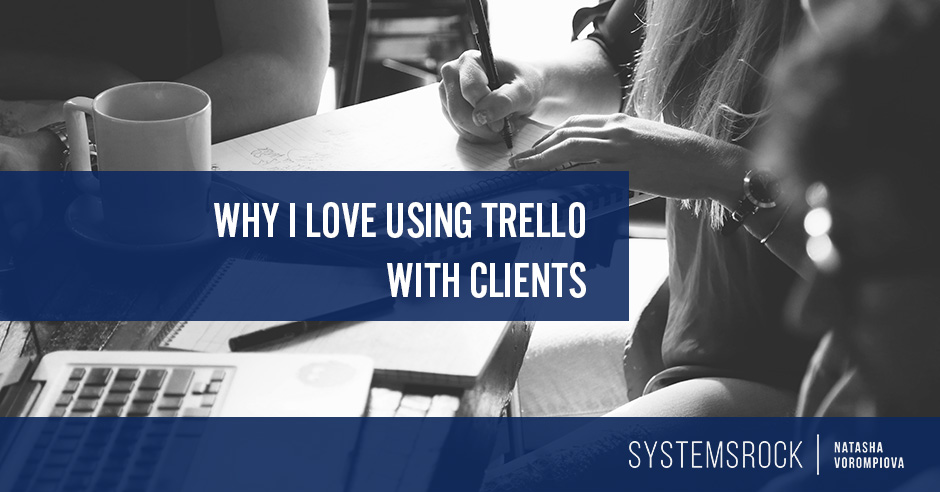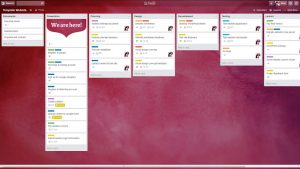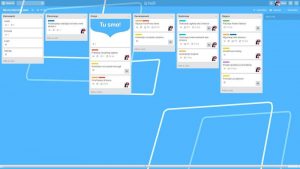 by Nela Dunato
by Nela Dunato
I’ve been resisting bringing my clients into a project management system for years. I’ve felt like a noob doing project communication over email, but making the jump was scary. What if my clients don’t like it?
Then one day I read Natasha’s post, that lit a fire under my butt, and over the course of the next two days I had created my Trello project board templates, as well as a PDF user guide, and started using this system on my very next client project.
I’ve been a happy Trello user for years: I use it for my editorial calendar, for keeping track of my business operations, for passion projects, as well as various team projects I run. I’ve converted at least twenty other people to Trello, and they loved it so much, they started using it for their own business, school, and personal projects.
Here are seven great ways that Trello has transformed my client relationships, and how it makes running client projects a breeze.
1. Clear organization
When running a project through email, there are so many questions:
- Do you keep all project correspondence in a single Gmail thread, or do you start a new conversation with a relevant subject for all deliverables and phases of the project?
- Do you attach files directly, or upload to Dropbox and send a link to it?
- How do you keep track of emails to reply to, and those you’re awaiting a reply from?
And even when you figure that all out, what about those emails from clients who ask you to re-send them their files again, because they can’t find them in their busy inbox?
With Trello, it’s clear where the communication should be happening (hint: in the comments section of the card that corresponds to the task), and all files are easy to find – both now AND later.
2. Focus
How many times have you jumped “real quick” into your inbox to retrieve a piece of information you need to work on a project, only to get lost in the newsletters, chatting with friends, and so on?
Now, I keep all the information I need to work in Trello and on my hard drive, and there’s no need to check email until I’m ready to read and process email.
The only additional tab I leave open as I work is the corresponding Trello board, and this enables me to focus on my work and complete it faster.
3. Extra Accountability
I’m sure you already have a system for keeping track of deadlines as you’re juggling multiple projects at any given moment. I used to use my general “Client projects” Trello board for that, but not anymore!
Now, I mark the deadlines for each task at the beginning of the project in my shared project board, both for my own activities and the client’s activities. That way, I know whether we’re on track, and the client knows by when I expect their content, feedback and payment, without me having to spell it out.
4. Reassurance
You know that sometimes when you have a lot of work to do without client’s direct input they won’t hear from you for days and sometimes this makes them a little restless?
If they want to check up on the project, they can see what I’m currently working on, and the progress I’m making as I’m checking off the tasks that are already completed.
It works both ways – when my clients are preparing website content, if they’re diligent in checking off the tasks that correspond to pages, I can get an idea of how far along they are (and whether they’re doing anything at all).
[clickToTweet tweet=”What @nelchee loves about using Trello, and you will, too! @SystemsThatRock http://bit.ly/2azv0VZ” quote=”What Nela Dunato loves about using Trello, and you will too!”]
5. Differentiation
We’re constantly looking for ways to differentiate ourselves from our peers through our core services, our branding, our copy… Your client experience can also be a way to stand out from other service providers.
It’s likely that you’re not the first expert your clients have hired. You may not even be the first designer / developer / writer / marketer / VA / coach they’ve worked with. The majority of our colleagues still uses email for project management, as I did until recently. By designing your client process intentionally, and creating a system to easily keep track of it you will raise your services above and beyond any of your competitors.
Wouldn’t you like to stick in your client’s memory as the super-organized and professional one, who first introduced them to the world of proper project management?
6. The delight factor
This is one of my favorite transformation due to my use of Trello, since as a designer, I enjoy making objects and experiences beautiful.
Trello Gold enables you to use custom board backgrounds (and you can earn Trello Gold by inviting new users). All my boards are branded with my own imagery, so it feels like an extension of my website.
When I have a repeat client whose brand I’ve designed before, I use their branded images as backgrounds. That way, when I invite them to the board, they feel like they’ve landed into their own hub, and not some generic faceless app.
One of my clients was so thrilled when they saw Trello for the first time, they asked me to send them the background to use as a cover photo on social media. (And of course I did, at no additional cost – that’s what it means to delight your clients.)
Maybe you’re not a designer, but that doesn’t mean you can’t make your boards beautiful with a custom wallpaper.
7. Clients can still use email if they want to
Trello has on-site, app and email notifications, so anyone can choose the way they want to be notified. I keep email notifications off in Trello in order to keep my inbox clear, since I check Trello more often that I check anything else, anyway. But I instruct my clients to turn on Trello email notifications, so they don’t miss out on any updates. This way you can have your cake and eat it too!
You can also send content from email to your Trello board by using a special private email address.
Are you in?
I hope that I’ve demonstrated why switching from email to Trello has been great for my business, and would be good for your business, too. Don’t let it remain just a “good idea” you never implement. Natasha’s post can help you get started with setting up your boards.
I challenge you to test this way of working on your next client project. If you end up hating it, there’s no harm done – you can always go back to the old way.
But something tells me you won’t want to… 🙂
BIO
 Nela Dunato is freelance brand & web designer from Croatia. She runs a boutique design consultancy that helps micro-businesses evolve into premium brands and connect with their dream clients, by crafting extraordinary visual experiences.
Nela Dunato is freelance brand & web designer from Croatia. She runs a boutique design consultancy that helps micro-businesses evolve into premium brands and connect with their dream clients, by crafting extraordinary visual experiences.
She also teaches graphic design and content marketing classes and workshops, and shares tips & insights on her blog.
Get her free Authentic Promotion Guidebook. A workbook that helps you create a totally unique, non-sleazy promotion plan that will save your time, energy and sanity.




